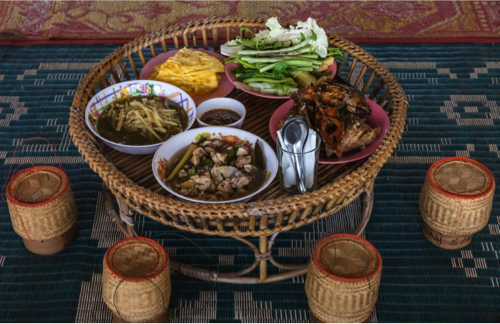One of the most laidback countries in Southeast Asia, a trip to Laos can help restore the vigor you’ve lost to endless days of work, responsibilities, and an overburdened schedule. Relaxed Laotian days consist of inexpensive touring where you can wander through thick forests, Buddhist holy sites, and fertile rice paddies, all while eating some of the most scrumptious and memorable food you’ll ever encounter. If you’re considering a trip to Laos, pack your appetite, because it will be routinely and refreshingly engaged each and every meal.
Called Lao cuisine, Laotian food really is different from other Southeast Asian cuisine. Staples include sticky rice, galangal, lemongrass, and padaek — a Lao fish sauce. The combination of these ingredients, coupled with the continuing influence of the French in cooking are what make the food so special. Here are a handful of dishes you have to try after you’ve taken a flight to Laos.

1. Klao Niaw
The cornerstone of every meal eaten in Laos, klao niaw — or sticky rice — is eaten by Laotians at a rate of almost 350 pounds per person per year, which is considerably more than any other country. Because sticky rice takes longer to digest than regular white rice, eaters can go longer between meals — a helpful feature in an agrarian society like Laos’. Served in a little woven basket at each meal, you roll the rice by hand into small balls before dipping it into food and sauces and eating it with your fingers.
2. Laap
Arguably the most popular dish in Laos, laap is a meat salad made from almost any kind of chopped meat — pork, beef, duck, fish, chicken, etc. — that has been tossed with lime juice, crushed and roasted rice, garlic, and herbs. Served at room temperature, this nutritionally dense dish may be served with meat that is either raw or cooked, although restaurants tend to serve the cooked version.
3. Tam Mak Houng
Unlike the papaya salads found in other Asian countries, this papaya salad is grittier, spicier, and saltier than it’s less flavorful and sweeter cousins found in Thailand, Cambodia, and Vietnam. The inclusion of padek — Lao fermented fish sauce — is what makes all the difference. Padek is made from mud fish, and unlike the fish sauces common in other regions, it’s a dark, thick, chunky, and strong sauce that makes its presence known immediately in tam mak houng. For some people the flavors in tam mak houng are an acquired taste, but if you have an adventurous palette, you should love it immediately.
4. Oh Lam
A hearty stew made from vegetables, oh lam commonly includes eggplant, squash, mushrooms, and beans. Flavored with lemongrass, coriander, sa kan — a bitter root herb — and spicy chilies, the stew takes hours to prepare in order for the ingredients to season it properly. Oh lam is thickened with sticky rice just before being served. Some versions of the dish do include meat. Also, if the bitter root sa kan ends up in your bowl, don’t eat it. Just chew it to release its astringent flavors in your mouth and then spit it out.
5. Kai Phaen
Similar to Japanese nori, kai phaen is a river weed that is commonly used to flavor curries and soups. It’s also enjoyed deep-fried as a thin sheet that has been sprinkled with sesame seeds. It makes a delicious, quick, and healthy snack, especially if you eat it with sticky rice.
6. Khao Jee
The Laotian name for baguette, Khao Jee really is just a crusty, fresh-made French baguette, and it’s one of the most popular street foods available. Khao Jee is from the days when Laos was part of French Indochina, and baguettes and other French foods maintain their popularity in the country. Common baguette fillings and toppings include sausage, shredded radishes and carrots, pork liver pate, and cucumber slices with mayonnaise and chili sauce.
7. Sai Oua
Lao sausage, sai oua is similar to Thailand’s most popular sausage, Chiang Mai. Made with pork, lemongrass, lime, chilies, and galangal, you can easily spot these ubiquitous sausages drying along roadside food stands or in markets. Served with a delicious, dry chili sauce called nam cheo, the sausage also usually comes with sticky rice.
Whether in Laos for business or pleasure, make sure you’re ready to eat. From the spices and textures to the aromas and flavors, eating Lao cuisine is an experience unlike any other in the world.


 Getting a Bamboo Tattoo in Thailand
Getting a Bamboo Tattoo in Thailand 1 Year Living in Bangkok
1 Year Living in Bangkok  Packing List Revisited 2013
Packing List Revisited 2013  Tiger Kingdom, Chiang Mai, Thailand
Tiger Kingdom, Chiang Mai, Thailand  Covent Garden, London, UK
Covent Garden, London, UK 

{ 0 comments… add one now }